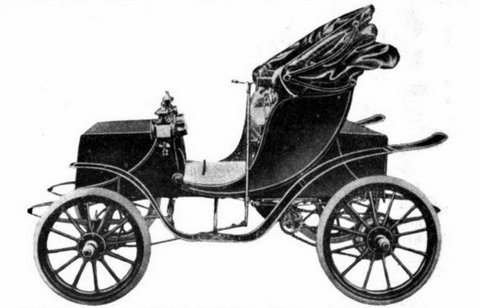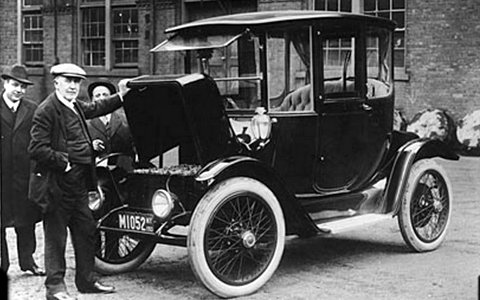It All Began in the More than a Century Ago
Story by Martin Banks
With the recent growth of the electric automobile industry, it’s no surprise that EVs are a hot topic of conversation. Whether it’s a Tesla, the Chevy Bolt or Nissan Leaf, it’s getting more common to see electric cars on the road.

Companies across the world are transitioning their fleets to either fully electric or hybrid systems. There are environmental benefits to this green technology, as electric vehicles help to reduce our carbon emissions. However, it’s worth noting that battery-powered vehicles have been around for more than a century. During the early 1900s, there was a golden age of electric cars, when they made up more than one-third of car sales in the U.S.
In the early 20th century, people traded in their horses for more advanced vehicles that improved transportation and allowed the country to grow and thrive. For comparison, today only one percent of our current national fleet consists of electric vehicles.
Let’s dive into electric cars from the 1900s and explore the reasons for their popularity.
Growing Popularity of Electric Cars in the U.S.
At one point, many people found electric cars to be the perfect alternative to traditional modes of transportation. However, electric vehicles also had their drawbacks. They were expensive, slow and challenging to drive on dirt roads or in rural areas. Because of their cost and limited mile range, city dwellers—especially women—were early big fans of electric vehicles.
Around 1890, the first electric car debuted in the U.S. It was invented by Scottish chemist William Morrison. Since then, his invention sparked (pun intended) an electric automobile revolution that made other modes of transportation seem antiquated.
EVs vs. ICE Vehicles
Cars during this time were powered by one of three methods: steam, gasoline or electricity.
Gasoline-powered vehicles had internal combustion engines (ICE). They were often tedious to start, especially on a cold morning. It would sometimes take 45 minutes for a car to warm up. Additionally, they required a hand crank to start, which took some physical strength to turn. They were noisy, smelled strange and vibrated while driving.
Steam-powered cars, of which there were many, featured an external combustion process that yielded a powerful car, but those cars were slow to get started and less efficient than ICE vehicles once they got going.

Even so, there was stiff competition between traditional and electric vehicles. Both had their advantages and disadvantages—it was challenging to know which type of vehicle would reign supreme at that point when dozens of small car companies competed for attention.
However, as time passed, it was clear that ICE cars became a more appealing option—drivers could travel farther distances without worrying about recharging their low-capacity batteries. Henry Ford, in spite of his interest in building an electric car that prefigured the later, successful Model T. Once Ford shifted gears to the Model T and other competitors stepped up, the electric car (and the steam car for other, but related reasons) was left behind.
Here are some other examples of popular EVs in the early 1900s.
1906 “One Hundred Mile” Frichtle
In Cleveland, Ohio, Oliver Frichtle claimed his battery-powered car could make it 100 miles before needing a charge. Once he proved it on a road trip, the car became popular amongst elite women who liked the extra room within the vehicle.
1912 Detroit Electric
Detroit Electric was making 13,000 electric cars annually by 1912. This was a production record for this time, and it was clear that Detroit Electric was a frontrunner in the industry.
1910 Baker Victoria
Baker Electric Motor Vehicle Company set a record in 1910 by driving the farthest distance on a single charge. The trip was just over 200 miles, and the Victoria traveled at a speed of 12 miles per hour. Today, one of these cars is owned by Jay Leno.
Electric Cars in the Modern World
It’s surprising to learn about the ebb and flow of the electric car market. So many people believe this technology is new side, but electric cars have a rich and interesting history. The lessons from those earlier days still apply to the latest generation EVs. They have clear advantages compared to internal combustion engine vehicles, but they also have drawbacks. We’ll have to see how this current version of the EV vs. ICE battle plays out.
Related Stories You Might Enjoy:
Opinion: The Importance of Learning What It Means To Live with an EV
Analysis: What the Best Way to Market EVs?

Great content! Keep up the good work!
Thanks for the kind words. –Ed.
It’s easy to overlook just how far back the electric vehicle market goes, as it’s not exactly a new trend. It’s one that can be traced back throughout history and this piece does a good job of detailing the major points.
Thanks, Michael. There is a rich history to explore.
One correction to the article, Steam engine are not ICE… They are external combustion engines by definition.
@Duane Moore,
Thanks for catching that. We’ll update that article to reflect your good historic point. Interesting that in the early days (circa 1910) consumers had the choice of ICE, EV & steam and the market was fairly evenly split between the three very different technologies. –ed.